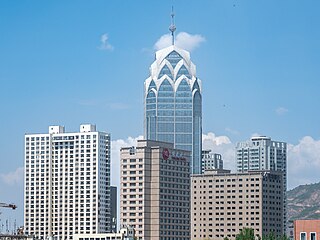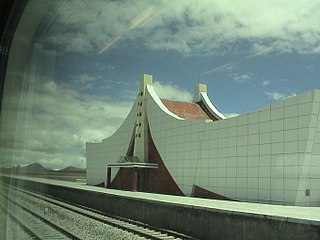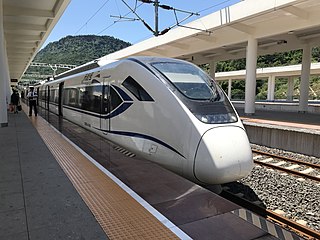
Lhasa, officially the Chengguan District of Lhasa City, is the inner urban district of Lhasa City, Tibet Autonomous Region, Southwestern China.

Xining is the capital and most populous city of Qinghai province in western China and the largest city on the Tibetan Plateau. As of the 2020 census, it had 2,467,965 inhabitants, of whom 1,954,795 lived in the built-up area made of 5 urban districts. The city lies in the Huangshui River Valley, also known as Tsongkha, and owing to its high altitude, has a cool climate on the borderline between cool semi-arid and dry winter humid continental.

The Qinghai–Tibet railway or Qingzang railway, is a high-elevation railway line in China between Xining, Qinghai Province, and Lhasa, Tibet. With over 960 km (600 mi) of track being more than 4,000 m (13,123 ft) above sea level, it is the highest railway line in the world.

Shigatse, officially known as Xigazê, or Rikaze, is a prefecture-level city of the Tibet Autonomous Region of the People's Republic of China. Its area of jurisdiction, with an area of 182,000 km2 (70,271 sq mi), corresponds to the historical Ü-Tsang region of Tibet.

The Tanggu La, Tangla Pass, or Tanggu Pass is a wide mountain pass in Southwest China over 5,000 meters (16,000 ft) in elevation, used by both the Qinghai–Tibet Highway and Qinghai–Tibet Railway to cross the Tanggula Mountains. These mountains on the Tibetan Plateau separate the Tibet Autonomous Region from the Qinghai province, and also form part of the watershed separating the Yangtze River to the north from a zone of endorheic basins with internal drainage to the south.
The Lanzhou–Qinghai railway, abbreviated as the Lanqing railway was built as the first step of an ambitious plan set by the People's Republic of China to connect Tibet with the rest of China by railway. LanQing railway, designed in 1956 and built from May 1958 to September 1959, runs 188 Kilometers long, connecting Lanzhou, the capital city of Gansu province, and Xining, the capital city of Qinghai province.

Damxung railway station is a railway station on the Qinghai–Tibet railway line in Damxung County, Lhasa, Tibet.

The Tanggula (Dangla) railway station is a railway station located in Amdo County, Tibet Autonomous Region, China, near the border with the Tanggula Town, Qinghai Province. The railway station has three tracks, one of them served by a platform, and another one served by a very short stub platform.

Lhasa Gonggar Airport is the airport serving Lhasa, the capital city of the Tibet Autonomous Region, People's Republic of China. It is about 97 kilometres (60 mi) to Lhasa and about 62 kilometres (39 mi) southwest of the city in Gyazhugling, Gonggar County of Shannan.

The following outline is provided as an overview of and topical guide to Tibet:

Xining railway station is the main railway station serving the city of Xining in Qinghai, China. It is the first station on the Qinghai–Tibet Railway which connects the city with Lhasa in Tibet.
Keke railway station is a station on the Chinese Qingzang Railway, located in Keke, Ulan County, Haixi Mongol and Tibetan Autonomous Prefecture, Qinghai Province, People's Republic of China. The station was built in 1979. The distance from Xining to Keke railway station is 426 km. The station is under the jurisdiction of the Qinghai–Tibet Railway Company.

The Shigatse Dzong, also known as Samdruptse Dzong, is located in Shigatse, Tibet, China. It is spelt Rikaze Dzong.

Kodari is a small village located at the border with Tibet-China. The village is located at the end–point of the Arniko Highway, which connects Kodari with the capital city of Kathmandu. Kathmandu is 144 kilometres (89 mi) away from Kodari. Kodari is a major border crossing from Nepal into the Tibet Autonomous Region.

The Lhasa–Shigatse railway, or Lari railway, is a high-elevation railway that connects Lhasa to Shigatse (Xigazê), in the Tibet Autonomous Region. The travel time between Lhasa and Shigatse on this line is roughly three hours.

Shigatse railway station, officially Xigazê, is a railway station in Shigatse, Tibet Autonomous Region, China. It lies in Jiacuoxiong Township, Samzhubzê District. The station officially opened for operations on 16 August 2014.

The Sichuan–Tibet railway, Sichuan–Xizang railway or Chuanzang railway is a high-elevation and the National first-class trunk railway in China that will connect Chengdu, the capital of Sichuan province, and Lhasa, the capital of Xizang Autonomous Region, when fully completed. The line will be 1,629 km (1,012 mi) long, and significantly cut travel time from Chengdu to Lhasa from 48 to 13 hours.

Liuwu New Area or Niu New Area, officially Liuwu Subdistrict or Niu Subdistrict, is a subdivision of Doilungdêqên of Lhasa, Tibet in Western China. The Liuwu New Area is located southwest of downtown Chengguan, the old center of Lhasa.

The Liuwu Bridge (Chinese: 柳梧大桥; pinyin: Liǔ wú dàqiáo} crosses the Lhasa River linking downtown Lhasa, Tibet to Lhasa railway station and Niu New Area on the south bank. It was built in conjunction with the Qinghai–Tibet Railway, which terminates on the south side of the river, and provides a connection to the town center on the north side.
The China–Nepal Railway is a planned railway between China and Nepal. The railway will link Kathmandu with Shigatse, Tibet, crossing the China–Nepal border at Gyirong–Rasuwa.

























